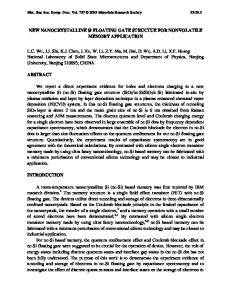Enhancement of Nonvolatile Floating Gate Memory Devices Containing AgInSbTe-SiO 2 Nanocomposite by Inserting HfO 2 /SiO
- PDF / 530,864 Bytes
- 6 Pages / 432 x 648 pts Page_size
- 35 Downloads / 357 Views
Enhancement of Nonvolatile Floating Gate Memory Devices Containing AgInSbTe-SiO2 Nanocomposite by Inserting HfO2/SiO2 Blocking Oxide Layer Kuo-Chang Chiang, Tsung-Eong Hsieh Department of Materials Science and Engineering, National Chiao Tung University, 1001 Ta-Hseuh Road, Hsinchu, Taiwan 30010, R.O.C. ABSTRACT This work presents an enhancement of nonvolatile floating gate memory (NFGM) devices comprised of AgInSbTe (AIST) nanocomposite as the charge-storage trap layer and HfO2 or HfO2/SiO2 as the blocking oxide layer. A significantly large memory window (ΔVFB) shift = 30.7 V and storage charge density = 2.3×1013 cm−2 at ±23V gate voltage sweep were achieved in HfO2/SiO2/AIST sample. Retention time analysis observed a ΔVFB shift about 19.3 V and the charge loss about 13.4% in such a sample under the ±15V gate voltage stress after 104 sec retention time test. Regardless of applied bias direction, the sample containing HfO2/SiO2 layer exhibited the leakage current density as low as 150 nA/cm2 as revealed by the current-voltage (I-V) measurement. This effectively suppresses the electron injection between gate electrode and charge trapping layer and leads to a substantial enhancement of NFGM characteristics. INTRODUCTION Nonvolatile floating gate device (NFGM) comprised of metallic nanocrystals (NCs) as the discrete charge-storage traps has been widely investigated in recent years. The charge trapping layers comprised of transition metals such as cobalt (Co) [1], platinum (Pt) [2] and nickel (Ni) [3] NCs embedded in high-k dielectrics have attracted a lot of attentions due to the advantages including higher density of states around Fermi level, wide range of work functions, smaller energy disturbance and stronger coupling with the conduction channel [4]. Such NFGM devices exhibited better memory window (ΔVFB) shifts and superior charge retention characteristics in comparison with those containing semiconductor NCs. Nevertheless, some drawbacks, for instance, the metal/dielectric oxides interaction and element interdiffusion during subsequent integration and high-temperature annealed processes would deteriorate the retention performance of NFGM [5]. Meanwhile, for improving the program/erase efficiency and charge retention property, HfO2 has been recognized as one of the promising blocking oxides to replace the conventional SiO2 owing to its relatively high dielectric constant, wide bandgap and large conduction band-offset with respect to Si [6]. However, HfO2 is relatively poor in inhibiting the oxygen (O) diffusion and boron (B) penetration when post annealing temperature exceeds about 400°C. This leads to a high leakage current and low carrier mobility due to the onset of
35
recrystallization [7]. In addition, a thin interfacial layer induced by oxidization and/or Hf diffusion was inevitably formed between HfO2 and Si substrate during either the deposition or post-annealing process [8]. Presently, the nitrogen (N) or aluminum (Al) incorporations have been proposed to suppress the recrystallization and block the ox
Data Loading...










